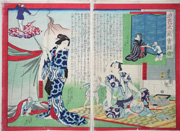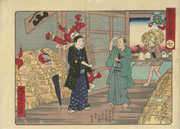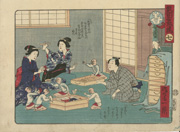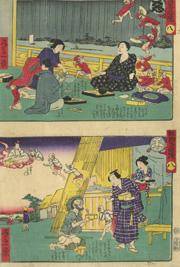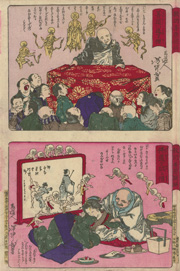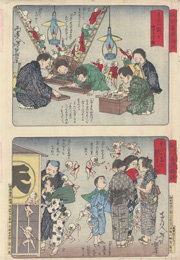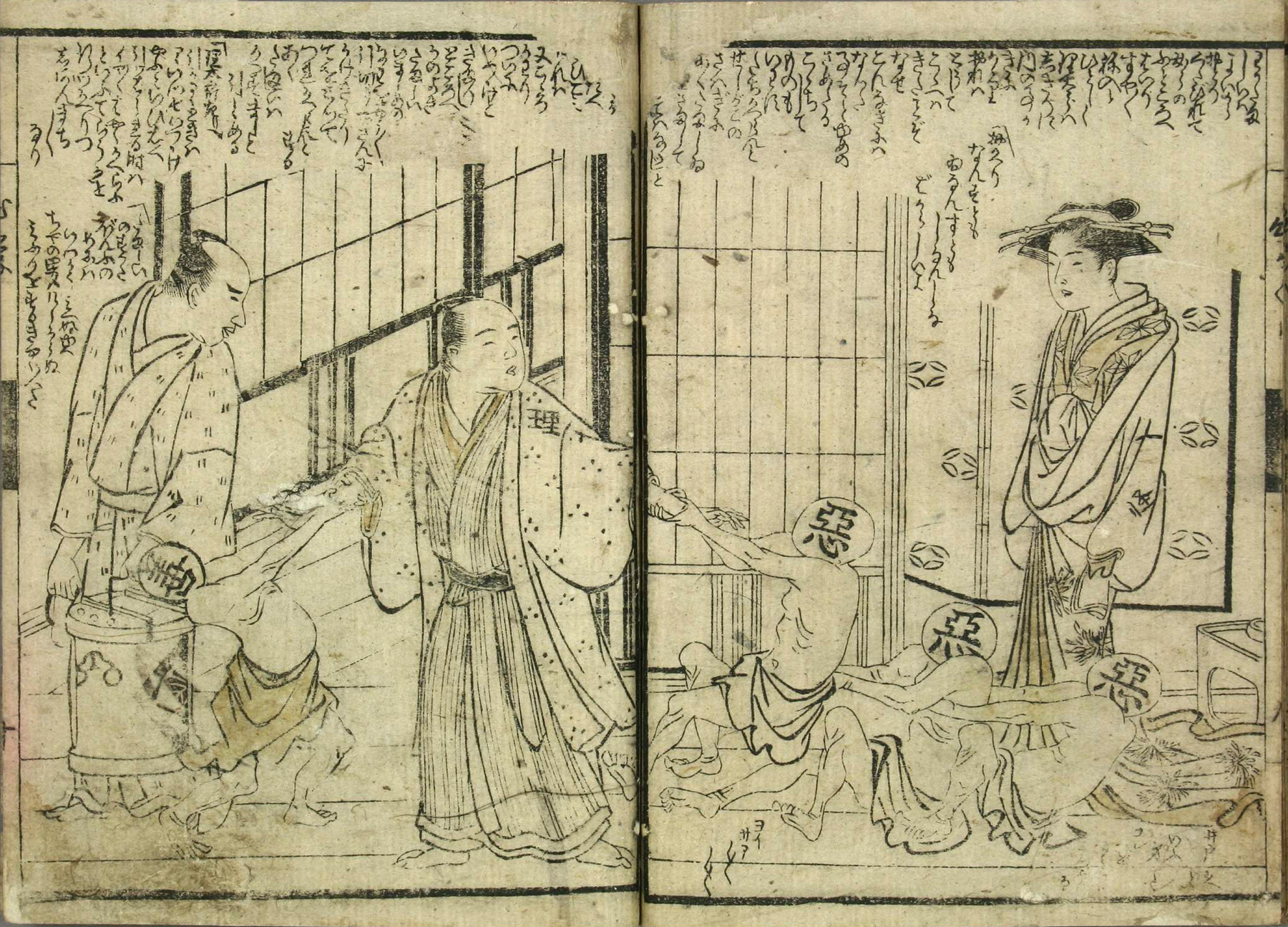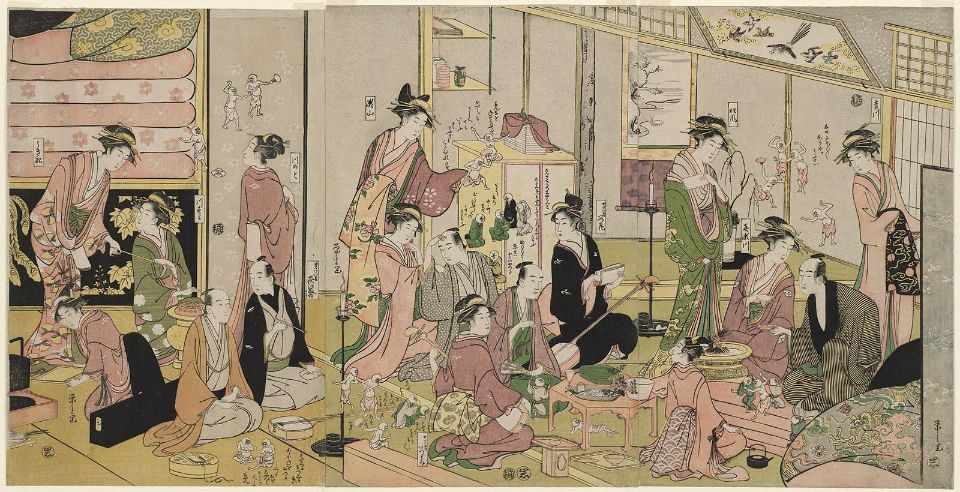Prints in Collection
IHL Cat. #646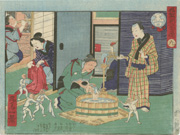 Good Parents from the series A Didactic Mirror of Good and Evil, 1872 Shōsai Ikkei (fl. c. 1870s) | IHL Cat. #670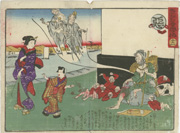 |
Representations of Good and Evil
Origins of Zendama and Akudama Figures in Japanese Prints
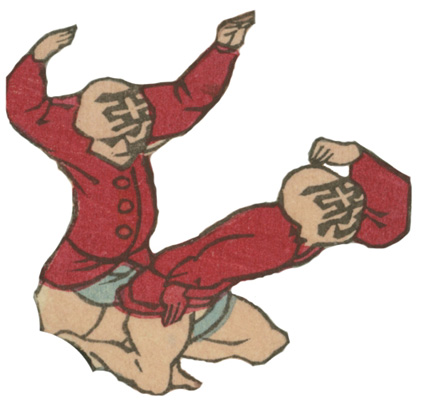 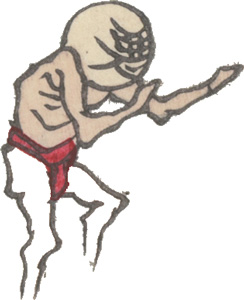 | 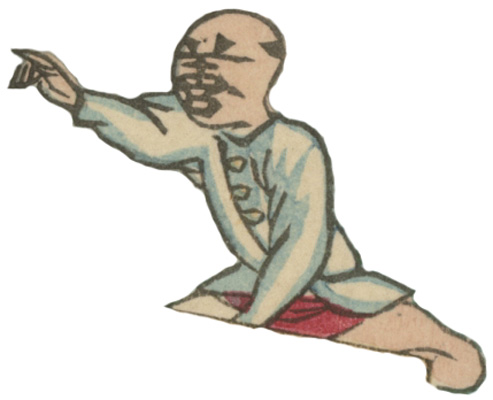 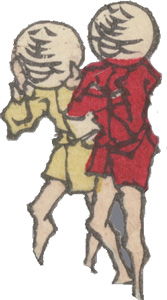 |
| Akudama 悪 (Evil Souls) | Zendama 善 (Good Souls) |
Ritarō stands confused, torn between the good and bad souls in the corridor outside the courtesan’s parlor.1
Shingaku hayasomegusa, 1790
Image: Waseda University Library http://archive.wul.waseda.ac.jp/kosho/he13/he13_03290/he13_03290.html
Shingaku hayasomegusa, 1790
Image: Waseda University Library http://archive.wul.waseda.ac.jp/kosho/he13/he13_03290/he13_03290.html
Shingaku hayasomegusa, variously translated as “Fast-dyeing Mind Study”; “Learning of the Mind (or Heart) in Fast Dyes” and “Shingaku: Quick-Staining Dye, Worker of Wonders,” was written three years after the introduction of the Tokugawa shogunate’s 1787 Kansei Reforms which attempted “to crack down on…the excesses and moral dissipation of the times.…”2 While writers, including Kyōden, initially satirized the Reforms, government censorship, which extended to the jailing of Kyōden and other writers, illustrators and publishers, resulted in works in which satire was replaced with thick layers of “ethical didacticism” such as Shingaku hayasomegusa.3
Kyōden’s book, which marries images and text4, is based on the then “popular school of Mind (or Heart) Learning (Shingaku 心学), a moral teaching aimed at the urban merchant and other commoners, which stresses moral practices and virtues like frugality and diligence to ward off evil tendencies in human nature.”5,6 As Shingaku’s teachings complemented the Kansei reforms, the book found its place as an instructional guide for the moral education of children.
Shingaku hayasomegusa dramatizes “the dangers of straying from the fundamental virtues” through the conflict between “good souls” (zendama) and “bad souls” (akudama) vying over the body of Ritarō, the son of the merchant Rihei. From birth, Ritaro has been protected by a “good” soul, but at the age of eighteen his body is invaded and taken over by a “bad” soul. Ritaro then goes on a tare and enters into a life of crime and debauchery. Finally he is rescued by a famous teacher named Dōri-sensei who reveals to him the truths of Shingaku. Ritaro becomes a model young man and is forgiven by all.7
The book was a hit, going into multiple printings, and its depictions of “good souls, bad souls” (zendama, akudama) became the subject of woodblock prints. The earliest print I've seen depicting zendama and akudama is a work dated to 1793-1794 by Eishi titled The Good and Evil Influences, pictured below, but it is almost certain that zendamas and akudamas began appearing in woodblock prints almost immediately after the publication of Shingaku hayasomegusa in 1790. It would be interesting to determine the last known woodblock print using these characters, but I have read that these figures still appear in contemporary graphic works.
The Good and Evil Influences, about 1793–94 (Kansei 5–6)
Chôbunsai Eishi, Japanese, 1756–1829
Museum of Fine Arts, Boston Accession Number 21.7374-6
Chôbunsai Eishi, Japanese, 1756–1829
Museum of Fine Arts, Boston Accession Number 21.7374-6
1Early Modern Japanese Literature: An Anthology, 1600-1900, Haruo Shirane, James Brandon, Columbia University Press, 2002, p. 723.
2 Ibid., p. 711.
3 Ibid.
4 Picture books that married image and text were known as kibyōshi 黄表紙 (‘yellow-cover booklets’).
5 “Scripts and Shapes: The Interplay of Chinese Characters and Japanese Syllabaries in Early Modern Japan,” Margarita Winkel appearing in The Idea of Writing: Play and Complexity, ed. Alexander J. de Voogt, Irving L. Finkel, Brill, 2010, p36.
6 As it evolved in the late eighteenth century, Shingaku stressed ‘knowing the original mind’ (honshin o shiru), a notion originally found in the Mencius (6A:10), which asserted that if one ignored the good impulses that arose naturally in one’s mind, one would ‘lose’ the true or original mind.
7 Shikitei Sanba and The Comic Tradition in Edo Fiction, Robert W. Leutner, Harvard University Press, 1985, p. 20.
